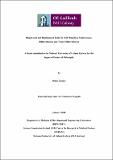| dc.description.abstract | Tendon injuries constitute an unmet clinical need, with 3 to 5 million new incidents occurring annually worldwide. Tissue grafting and biomaterial-based approaches fail to provide environments that are conducive to regeneration; instead they lead to nonspecific cell adhesion and scar tissue formation, which collectively impair functionality. Cell based therapies may potentially recover native tendon function, if tenocyte trans-differentiation can be evaded and cell differentiation / transdifferentiation towards tenogenic lineage is attained. To this end, recreating an artificial in vivo tendon niche by engineering functional in vitro microenvironments is a research priority. In this work, the effect of biophysical (macromolecular crowding, mechanical stimulation) and biochemical (oxygen tension) modulators on the behaviour of permanently differentiated cell sources (human adult and neonatal dermal fibroblasts and tenocytes) and stem cells (bone marrow derived mesenchymal stem cells) was assessed. Firstly, the influence of hydrodynamic radius, charge and polydispersity of (a) various concentrations of different crowders (carrageenan, Ficoll™ and dextran sulphate); (b) various molecular weights of different crowders (70, 400 and 100 kDa of Ficoll™ and 10, 100 and 500 kDa of dextran sulphate) and (c) various cocktails of the same crowders (cocktails of various concentrations of different molecular weights Ficoll™ and dextran sulphate) on extracellular matrix deposition in human dermal fibroblast culture was analysed. The different crowders were tested individually and carrageenan was found to induce the highest extracellular matrix deposition due to its natural polydispersity and negative charge, conducive to more efficient volume exclusion. Cocktails of different molecular weight / concentrations of Ficoll™ or dextran sulphate, although presented increased polydispersity than their mono-domain counterparts, did not match carrageenan’s performance. Carrageenan was utilised to accelerate extracellular matrix deposition in human bone marrow mesenchymal stem cells and it was found to outperform a Ficoll™ cocktail (70 kDa and 400 kDa). Additionally, under low oxygen conditions (2 %), increased matrix deposition was also observed. The multi-differentiation potential was maintained under both macromolecular crowding and hypoxia, though adipogenesis was significantly reduced after pre-treatment with 2 % oxygen tensionand chondrogenesis was significantly increased after pre-conditioning with macromolecular crowding. Finally, the combined effect of macromolecular crowding and mechanical stimulation on morphology, deposition of extracellular matrix and phenotype of human tenocytes, adult and neonatal dermal fibroblasts and bone marrow stem cells was assessed. Mechanical stimulation induced alignment perpendicular to the load of the permanently differentiated cell sources. Macromolecular crowding accelerated deposition of collagen type I. All cells deposited collagen types I, III, V and VI and bone marrow stem cells also deposited collagen type IV. Extracellular matrix synthesis was not increased by mechanical stimulation. Gene expression analysis revealed upregulation of scleraxis by tenocytes, potentially indicating phenotypic maintenance. Both neonatal and adult dermal fibroblasts presented upregulation of thrombospondin 4 and alkaline phosphatase or cartilage oligomeric protein, respectively, whilst the expression profile of bone marrow stem cells was unchanged. Taken together, these results provide further knowledge on the use of biophysical and biochemical in vitro microenvironment modulators for control of cell phenotype and development of tissue-like supramolecular assemblies. | en_IE |


